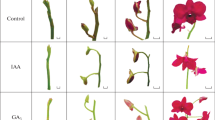Abstract
A single foliar spray of gibberellic acid (GA3) at concentrations of 125, 250, 500, or 1,000 mg L−1 induced flowering of Philodendron‘Black Cardinal’ (an interspecific hybrid developed from a series of crosses among P. wendlandii, hastatum, erubescens, imbe, fragrantissimum, and an unnamed species) in approximately 170 d. Percentage of plants induced and mean flower number per plant increased as GA3 concentrations increased. Compared to unsprayed plants, the number of new leaves decreased, petiole lengths of new leaves and length of the largest leaf increased, but leaf width was unaffected among sprayed plants. One hour before the spathe started to unfurl, spadix temperatures increased, and temperatures in the male portion of the spadix rose by 10 °C above ambient as the spathe fully opened. Elevated temperatures were recorded for about two hours and returned to ambient within five hours. Spathes remained open for about five hours. A creamy white spadix with a contrasting burgundy spathe resulted in more aesthetically pleasing plants than with foliage alone. Because of the short period of display, the open spathe would not increase additional ornamental value of Philodendron‘Black Cardinal’ in the marketplace. However, if breeding is the purpose of flowering induction, spathes should be cut away from the spadix to facilitate pollination.
Similar content being viewed by others
References
Alamu S. and McDavid C.R. 1978. Promotion of flowering in edible aroids by gibberellic acid. Trop. Agric. (Trindad) 55: 81–86.
Alamu S. and McDavid C.R. 1980. Note on the effects of B-9 and CCC on the growth and flowering of tannia (Xanthosoma sagittifolium) plants treated or not treated with GA. Trop. Agric. (Trindad) 57: 1221–1222.
Bailey L.H. and Bailey E.Z. 1976. Hortus III. Macmillan, New York, N.Y. 1290 pp.
Bald J.G. 1951. Gladiolus diseases. In: A progress report on current research compiled from discussions at Eighth Annual Convention, North American Gladiolus Council Cleveland, Ohio. January 15–18. 11 pp.
Corr B.E. and Widmer R.E. 1987. Gibberellic acid increases flower number in Zantedeschia elliottiana and Z. rehmannii. Hort-Science 22: 605–607.
Croat T.B. 1997. A Revision of Philodendron Subgenus Philodendron (Araceae) of Central America. Missouri Botanical Garden Press, St. Louis, MO.
Duncan E.J., Alamu S. and McDavid C.R. 1985. Araceae (Edible Aroids). In: Halevy A.H. (ed.), Handbook of Flowering. CRC Press, Inc., Boca Raton, Florida, pp. 504–508.
Gibernau M., Barabe D., Cerdan P. and Dejean A. 1999. Beetle pollination of Philodendron solimoesense (Araceae) in French Guiana. Int. J. Plant Sci. 160: 1135–1143.
Gottsberger G. and Silber-Gottsberger I. 1991. Olfactory and visual attraction of Erioscelis emarginata (Cyclocephalini, Dynastinae) to the inflorescence of Philodendron selloum (Araceae). Biotropica 23: 23–28.
Harbaugh B.K. and Wilfret G.J. 1979. Gibberellic acid (GA3) stimulates flowering in Caladium hortulanum Birdsey. HortScience 14: 72–73.
Henny R.J. 1980. Gibberellic acid (GA3) induces flowering in Dieffenbachia maculata 'Perfection'. HortScience 15: 613.
Henny R.J. 1981. Promotion of flowering in Spathiphyllum 'Mauna Loa' with gibberellic acid. HortScience 16: 554–555.
Henny R.J. 1983. Flowering of Aglaonema commutatum 'Treubii' following treatment with gibberellic acid. HortScience 18: 374.
Henny R.J. 1988. Inducing flowering of Homalomena lindenii (Rodigas) Ridley with gibberellic acid. HortScience 23: 711–712.
Henny R.J. and Hamilton R.L. 1992. Flowering of Anthurium following treatment with gibberellic acid. HortScience 27: 1328.
Henny R.J., Norman D.J. and Kane M.E. 1999. Gibberellic acidinduced flowering of Syngonium podophyllum Schott 'White Butterfly'. HortScience 34: 676–677.
Huxley A. 1994. The New Royal Horticultural Society Dictionary of Gardening. Vol. 3. Macmillan, London, 790 pp.
James W.O. and Beevers H. 1950. The respiration of Arum spadix. A rapid respiration, resistant to cyanide. New Phytol. 49: 353–374.
King R.W., Seto H. and Sachs R.M. 2000. Response to gibberellin structural variants shows that ability to inhibit flowering correlates with effectiveness for promoting stem elongation of some plant species. J. Plant Growth Reg. 19: 429–436.
Meeuse B.J. 1975. Thermogenic respiration in aroids. Ann. Rev. Plant Physiol. 26: 117–126.
Meesue B.J. and Raskin I. 1988. Sexual reproduction in the arum lily family, with emphasis on thermogenicity. Sexual Plant Reproduct. 1: 3–15.
McColley R.H. and Miller H.N. 1965. Philodendron improvement through hybridization. Proc. Fla. State Hort. Soc. 78: 409–415.
McConnell D.B., Henley R.W. and Kelly C.B. 1989. Commercial foliage plants: Twenty years of changes. Proc. Fla. State Hort. Soc. 102: 297–303.
Nagy K.A., Odell D.K. and Seymour R.S. 1972. Temperature regulation by the inflorescence of Philodendron. Science 178: 1195–1197.
Norris C.A. 1987. The business of breeding at Bamboo Nurseries. Grower Talks: 60–63, (January).
Raskin I., Ehmann A., Melander W.R. and Meeuse B.J.D. 1987. Salicylic acid: A natural inducer of heat production in Arum lilies. Science 237: 1601–1602.
Smith C.N. and Strain J.R. 1976. Market outlets and product mix for Florida foliage plants. Proc. Fla. State Hort. Soc. 89: 274–278.
Stamps R.H. and Evan M.R. 1999. Growth of Dracaena marginata and Spathiphyllum 'Petite' in sphagnum peat- and coconut coir dust-based growing media. J. Environ. Hort. 17: 49–52.
Tang W. 1987. Heat production in cycad cones. Bot. Gaz. 148: 165–174.
Wilfret G.J. and Sheehan T.J. 1981. Development of new foliage plant cultivars. In: Joiner J.N. (ed.), Foliage Plant Production. Prentice-Hall, Inc., Englewood Cliffs, N.J. pp. 126–136.
Wilkins H.F. 1985. Caladium x Hortulanum. In: Halevy A.H. (ed.), Handbook of Flowering. CRC Press, Inc., Boca Raton, Florida, pp. 101–104.
Author information
Authors and Affiliations
Rights and permissions
About this article
Cite this article
Chen, J., Henny, R.J., McConnell, D.B. et al. Gibberellic acid affects growth and flowering of Philodendron‘Black Cardinal’. Plant Growth Regulation 41, 1–6 (2003). https://doi.org/10.1023/A:1027326705060
Issue Date:
DOI: https://doi.org/10.1023/A:1027326705060




